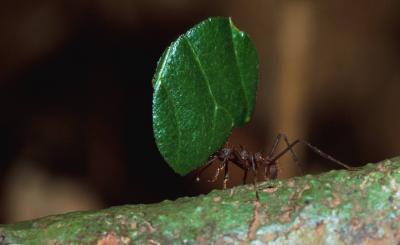The ants and their gardens work against invaders
New diseases often directly affect life and safety of human food. While ants cut leaves, one of the few social insects also cultivated crops, harvested leaves to fertilize their underground fungal gardens from 50 million years ago. New studies conducted by the Smithsonian Institute show that both ants and their mushroom crops can avoid strange fungi from breaking into the nest, thus ensuring their symbiotic relationship.
Sunshine Van Bael postdoctoral researcher at the Smithsonian Tropical Research Institute explains: 'When you look at a healthy tropical tree, you think you're just seeing a creature. Some of them can protect plants by eliminating pathogens'. The fungus that lives inside the leaf does not cause disease to the plant called endophyte. 'Endo' thinks 'inside' , while 'phyte' means 'plant'.
'We know that leaf-cutting ants can guarantee their gardens' hygiene in an extraordinary way. But we also wonder if the fungus that lives in the leaves can make it less appealing to ants, and whether it protects the tree from the ants' invasion. Since most of the leaves in the wild contain endophytes, we wonder how the process of preparing the leaves of ants affects the endophyte in the nest '.
 On the photo is ant cut leaves. (Photo: STRI archives)
On the photo is ant cut leaves. (Photo: STRI archives)
Van Bael and colleagues used the laboratory ants in a leaf-cutting ant species Atta colombica to test the reaction of ants to tropical leaves of Merremia umbellata. In the experiment, the researchers changed the density of the endophyte Glomerella cingulata, and gave the ants the leaves with high or low fungi.They also added 32 other endophyte types against the culture garden environment in the culture dish to see if they inhibited each other's growth.
The ants cut the leaves off the leaves that contain both high and low amounts of fungi, but they take longer to cut the leaves with higher amounts of mushrooms. Besides, the preparation of ants also significantly reduces the amount of fungi in each leaf piece before they are applied to the garden. The experiment on the culture plate also showed that the fungal species in the garden reduced the growth rate of 28 of the 32 other endophyte species tested, the experimental endophyte species with a faster growth rate. more affected. This proves that in addition to the sanitation activities of ants, the garden itself can compete with outside microorganisms.
Van Bael concluded that: 'The leaves in the leaves are not welcome in the garden of the leaf-cut ants'. Their study was published online in the Proceedings of the Royal Society B.
Refer:
Sunshine A. Van Bael, Hermógenes Fernández-Marín, Mariana C. Valencia, Enith I. Rojas, William T. Wcislo, Edward A. Herre.Two fungal symbioses collide: endophytic fungi are not welcome in leaf-cutting ant gardens.Proceedings of The Royal Society B Biological Sciences, 2009;DOI: 10.1098 / rspb.2009.0196
- Enjoy the most beautiful
- Solve for ant three compartments
- Discover strange ants in the world
- Ants also know how to build bridges
- Strange things about the ant world
- The group of ants is responsible for spawning the same species
- Why ants 'dominate' the world
- Special ants plant trees to nest on Fiji island
- Why does a thousand ant colonies never suffer from
- Lessons learned from ants
- This is what happens when an ant bites you, no wonder it hurts so much
- Video: The ants are robbing the eggs of the same kind to raise and make
 Animal 'suffering' after hibernation
Animal 'suffering' after hibernation Why do goats climb well?
Why do goats climb well? Scientists were surprised to see chimpanzees eating turtles
Scientists were surprised to see chimpanzees eating turtles Giant catfish died deadly due to drought in Thailand
Giant catfish died deadly due to drought in Thailand